IT Infrastructure Management Report: Data, Trends, and Analysis
VerifiedAdded on 2021/04/24
|6
|1132
|8
Report
AI Summary
This report delves into the multifaceted domain of IT Infrastructure Management, exploring key concepts such as electronic record management, business intelligence, and various data analysis techniques. The assignment examines the roles of data mining, text mining, and big data analytics in extracting actionable insights and supporting data-driven decision-making. Furthermore, it explores enterprise architecture, management information systems, and the data lifecycle, providing a comprehensive understanding of data management principles. The report also investigates the impact of data mining and text mining on business processes and identifies associated risks. Additionally, the report addresses the challenges and potential security threats associated with cloud computing, offering solutions such as data encryption and access control measures. The report concludes by emphasizing the importance of selecting trusted vendors to mitigate insider threats and ensure overall data security.
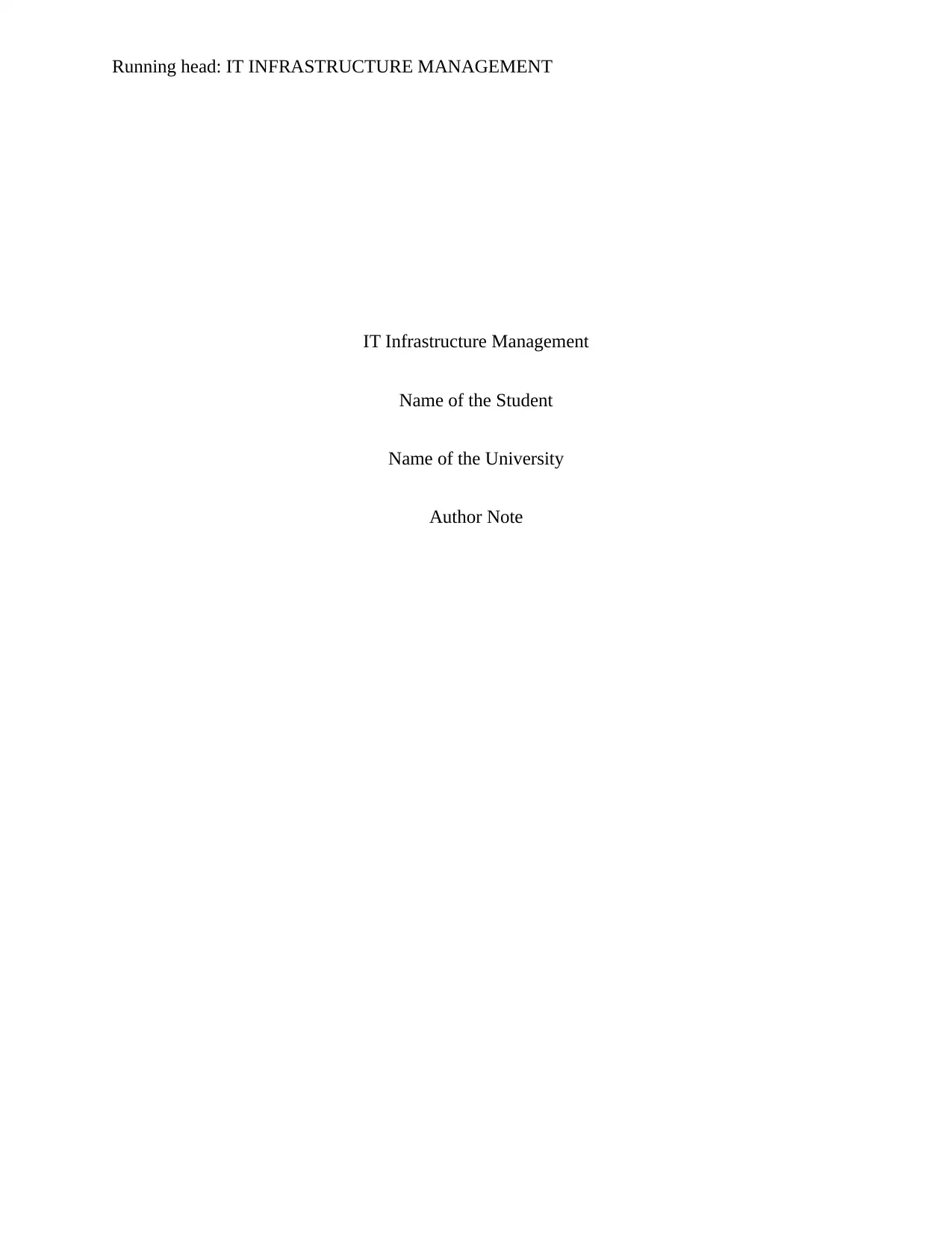
Running head: IT INFRASTRUCTURE MANAGEMENT
IT Infrastructure Management
Name of the Student
Name of the University
Author Note
IT Infrastructure Management
Name of the Student
Name of the University
Author Note
Paraphrase This Document
Need a fresh take? Get an instant paraphrase of this document with our AI Paraphraser
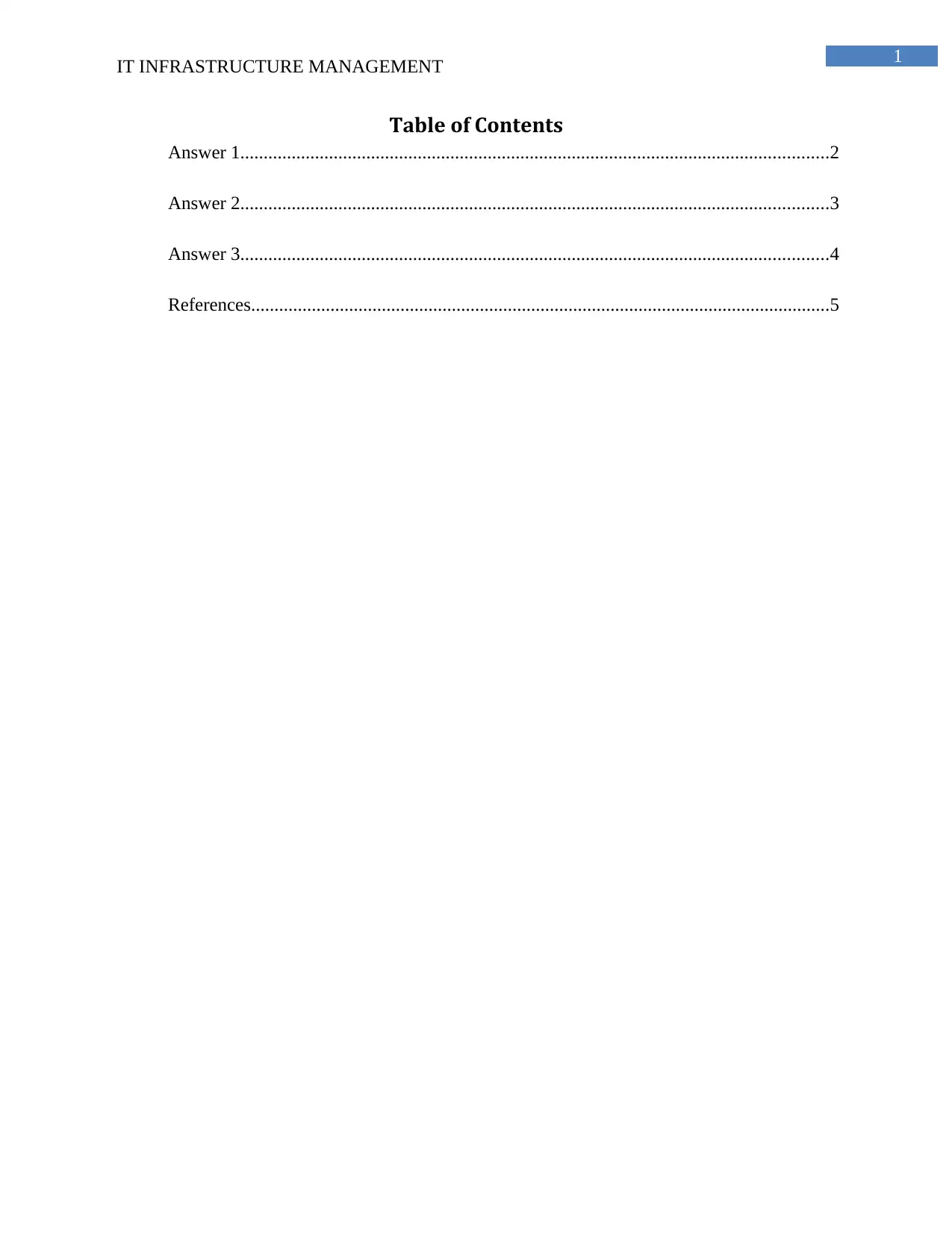
1
IT INFRASTRUCTURE MANAGEMENT
Table of Contents
Answer 1..............................................................................................................................2
Answer 2..............................................................................................................................3
Answer 3..............................................................................................................................4
References............................................................................................................................5
IT INFRASTRUCTURE MANAGEMENT
Table of Contents
Answer 1..............................................................................................................................2
Answer 2..............................................................................................................................3
Answer 3..............................................................................................................................4
References............................................................................................................................5
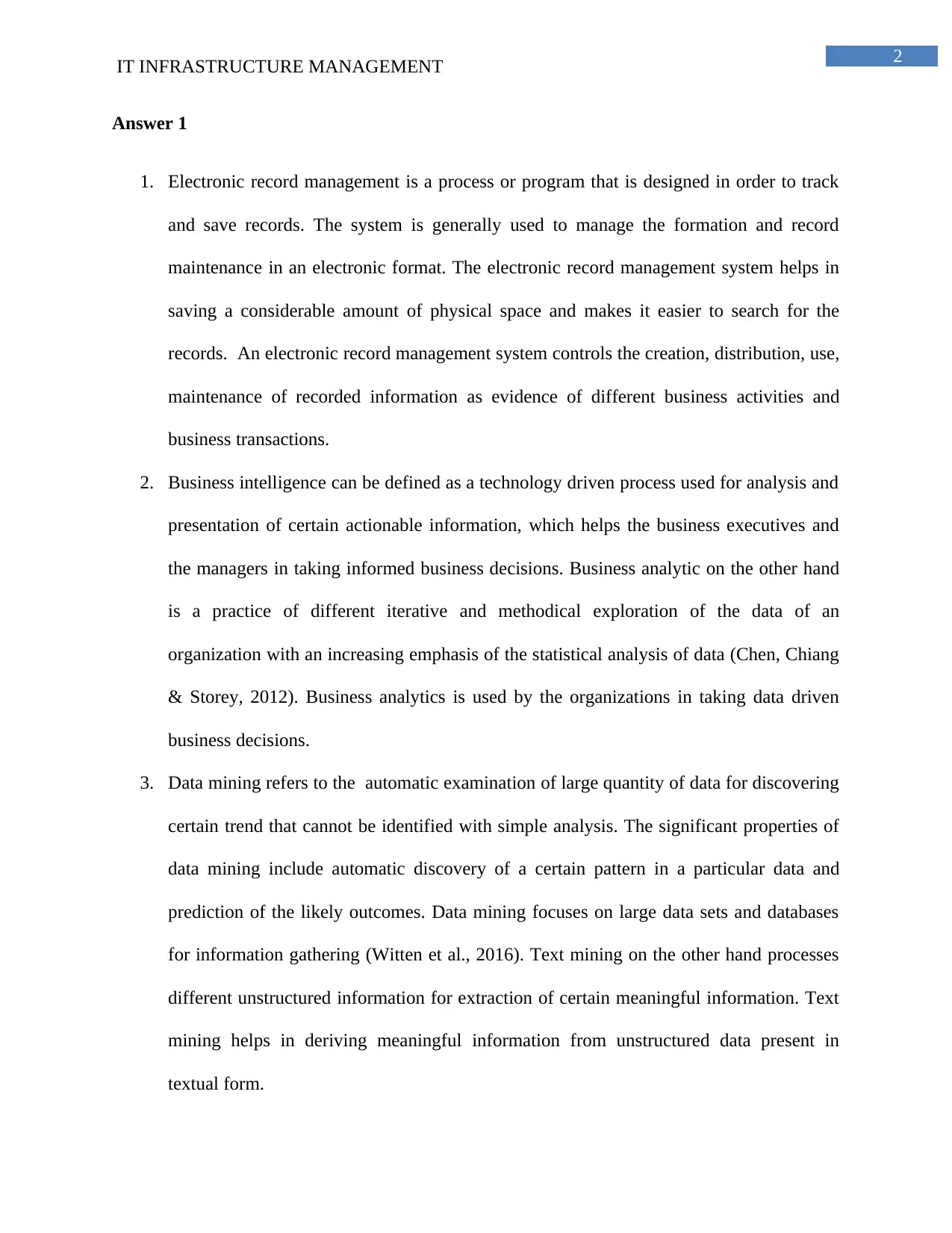
2
IT INFRASTRUCTURE MANAGEMENT
Answer 1
1. Electronic record management is a process or program that is designed in order to track
and save records. The system is generally used to manage the formation and record
maintenance in an electronic format. The electronic record management system helps in
saving a considerable amount of physical space and makes it easier to search for the
records. An electronic record management system controls the creation, distribution, use,
maintenance of recorded information as evidence of different business activities and
business transactions.
2. Business intelligence can be defined as a technology driven process used for analysis and
presentation of certain actionable information, which helps the business executives and
the managers in taking informed business decisions. Business analytic on the other hand
is a practice of different iterative and methodical exploration of the data of an
organization with an increasing emphasis of the statistical analysis of data (Chen, Chiang
& Storey, 2012). Business analytics is used by the organizations in taking data driven
business decisions.
3. Data mining refers to the automatic examination of large quantity of data for discovering
certain trend that cannot be identified with simple analysis. The significant properties of
data mining include automatic discovery of a certain pattern in a particular data and
prediction of the likely outcomes. Data mining focuses on large data sets and databases
for information gathering (Witten et al., 2016). Text mining on the other hand processes
different unstructured information for extraction of certain meaningful information. Text
mining helps in deriving meaningful information from unstructured data present in
textual form.
IT INFRASTRUCTURE MANAGEMENT
Answer 1
1. Electronic record management is a process or program that is designed in order to track
and save records. The system is generally used to manage the formation and record
maintenance in an electronic format. The electronic record management system helps in
saving a considerable amount of physical space and makes it easier to search for the
records. An electronic record management system controls the creation, distribution, use,
maintenance of recorded information as evidence of different business activities and
business transactions.
2. Business intelligence can be defined as a technology driven process used for analysis and
presentation of certain actionable information, which helps the business executives and
the managers in taking informed business decisions. Business analytic on the other hand
is a practice of different iterative and methodical exploration of the data of an
organization with an increasing emphasis of the statistical analysis of data (Chen, Chiang
& Storey, 2012). Business analytics is used by the organizations in taking data driven
business decisions.
3. Data mining refers to the automatic examination of large quantity of data for discovering
certain trend that cannot be identified with simple analysis. The significant properties of
data mining include automatic discovery of a certain pattern in a particular data and
prediction of the likely outcomes. Data mining focuses on large data sets and databases
for information gathering (Witten et al., 2016). Text mining on the other hand processes
different unstructured information for extraction of certain meaningful information. Text
mining helps in deriving meaningful information from unstructured data present in
textual form.
⊘ This is a preview!⊘
Do you want full access?
Subscribe today to unlock all pages.

Trusted by 1+ million students worldwide
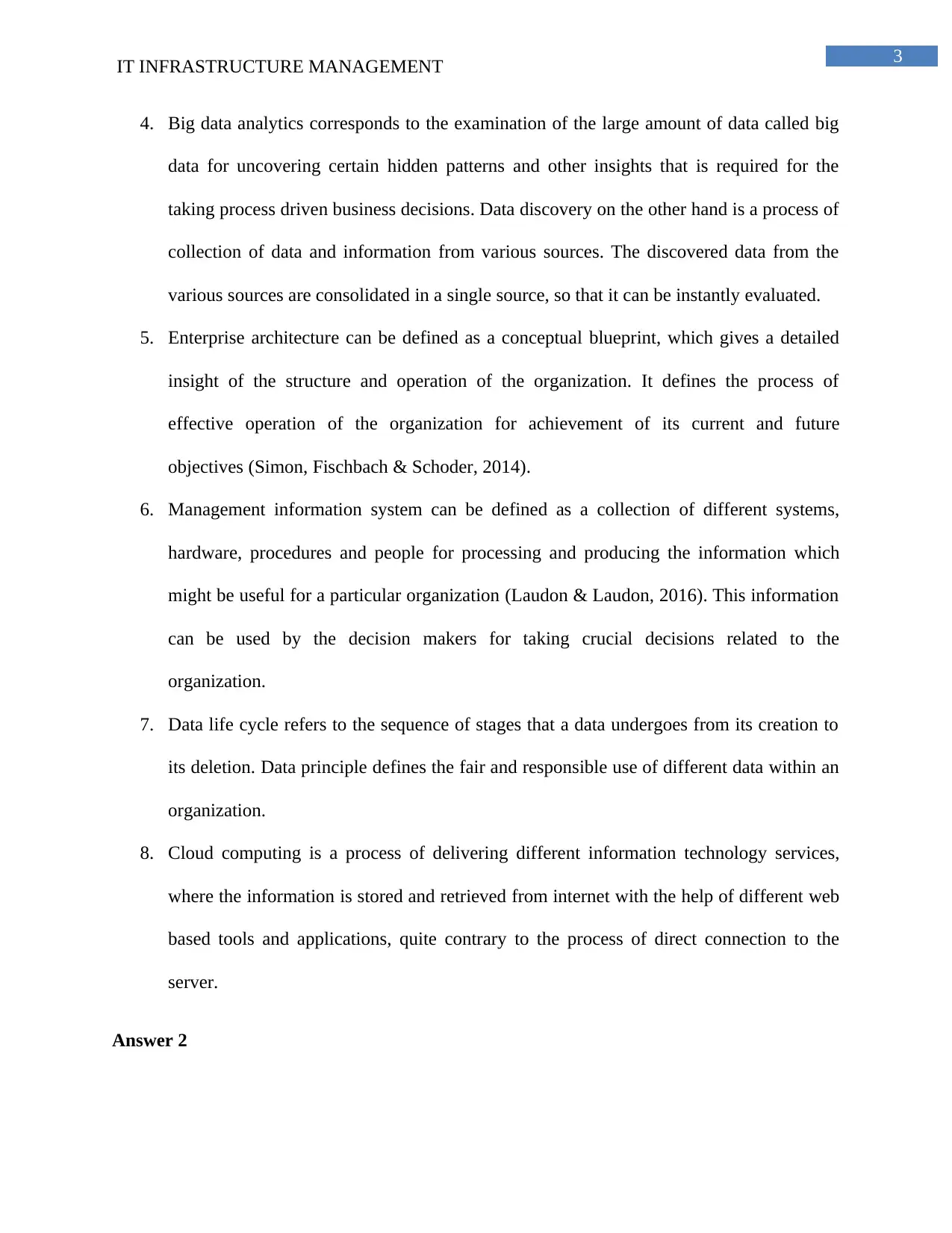
3
IT INFRASTRUCTURE MANAGEMENT
4. Big data analytics corresponds to the examination of the large amount of data called big
data for uncovering certain hidden patterns and other insights that is required for the
taking process driven business decisions. Data discovery on the other hand is a process of
collection of data and information from various sources. The discovered data from the
various sources are consolidated in a single source, so that it can be instantly evaluated.
5. Enterprise architecture can be defined as a conceptual blueprint, which gives a detailed
insight of the structure and operation of the organization. It defines the process of
effective operation of the organization for achievement of its current and future
objectives (Simon, Fischbach & Schoder, 2014).
6. Management information system can be defined as a collection of different systems,
hardware, procedures and people for processing and producing the information which
might be useful for a particular organization (Laudon & Laudon, 2016). This information
can be used by the decision makers for taking crucial decisions related to the
organization.
7. Data life cycle refers to the sequence of stages that a data undergoes from its creation to
its deletion. Data principle defines the fair and responsible use of different data within an
organization.
8. Cloud computing is a process of delivering different information technology services,
where the information is stored and retrieved from internet with the help of different web
based tools and applications, quite contrary to the process of direct connection to the
server.
Answer 2
IT INFRASTRUCTURE MANAGEMENT
4. Big data analytics corresponds to the examination of the large amount of data called big
data for uncovering certain hidden patterns and other insights that is required for the
taking process driven business decisions. Data discovery on the other hand is a process of
collection of data and information from various sources. The discovered data from the
various sources are consolidated in a single source, so that it can be instantly evaluated.
5. Enterprise architecture can be defined as a conceptual blueprint, which gives a detailed
insight of the structure and operation of the organization. It defines the process of
effective operation of the organization for achievement of its current and future
objectives (Simon, Fischbach & Schoder, 2014).
6. Management information system can be defined as a collection of different systems,
hardware, procedures and people for processing and producing the information which
might be useful for a particular organization (Laudon & Laudon, 2016). This information
can be used by the decision makers for taking crucial decisions related to the
organization.
7. Data life cycle refers to the sequence of stages that a data undergoes from its creation to
its deletion. Data principle defines the fair and responsible use of different data within an
organization.
8. Cloud computing is a process of delivering different information technology services,
where the information is stored and retrieved from internet with the help of different web
based tools and applications, quite contrary to the process of direct connection to the
server.
Answer 2
Paraphrase This Document
Need a fresh take? Get an instant paraphrase of this document with our AI Paraphraser
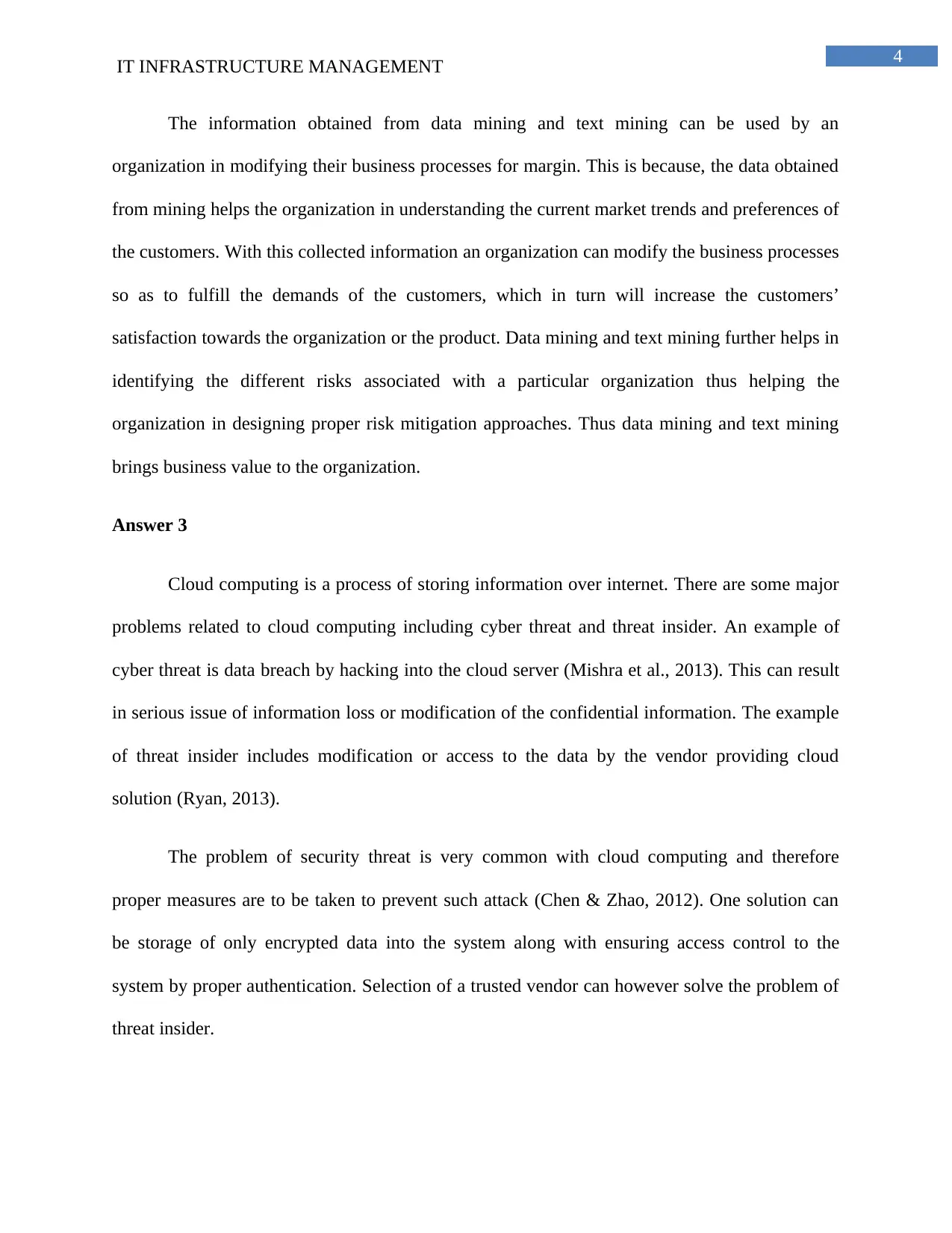
4
IT INFRASTRUCTURE MANAGEMENT
The information obtained from data mining and text mining can be used by an
organization in modifying their business processes for margin. This is because, the data obtained
from mining helps the organization in understanding the current market trends and preferences of
the customers. With this collected information an organization can modify the business processes
so as to fulfill the demands of the customers, which in turn will increase the customers’
satisfaction towards the organization or the product. Data mining and text mining further helps in
identifying the different risks associated with a particular organization thus helping the
organization in designing proper risk mitigation approaches. Thus data mining and text mining
brings business value to the organization.
Answer 3
Cloud computing is a process of storing information over internet. There are some major
problems related to cloud computing including cyber threat and threat insider. An example of
cyber threat is data breach by hacking into the cloud server (Mishra et al., 2013). This can result
in serious issue of information loss or modification of the confidential information. The example
of threat insider includes modification or access to the data by the vendor providing cloud
solution (Ryan, 2013).
The problem of security threat is very common with cloud computing and therefore
proper measures are to be taken to prevent such attack (Chen & Zhao, 2012). One solution can
be storage of only encrypted data into the system along with ensuring access control to the
system by proper authentication. Selection of a trusted vendor can however solve the problem of
threat insider.
IT INFRASTRUCTURE MANAGEMENT
The information obtained from data mining and text mining can be used by an
organization in modifying their business processes for margin. This is because, the data obtained
from mining helps the organization in understanding the current market trends and preferences of
the customers. With this collected information an organization can modify the business processes
so as to fulfill the demands of the customers, which in turn will increase the customers’
satisfaction towards the organization or the product. Data mining and text mining further helps in
identifying the different risks associated with a particular organization thus helping the
organization in designing proper risk mitigation approaches. Thus data mining and text mining
brings business value to the organization.
Answer 3
Cloud computing is a process of storing information over internet. There are some major
problems related to cloud computing including cyber threat and threat insider. An example of
cyber threat is data breach by hacking into the cloud server (Mishra et al., 2013). This can result
in serious issue of information loss or modification of the confidential information. The example
of threat insider includes modification or access to the data by the vendor providing cloud
solution (Ryan, 2013).
The problem of security threat is very common with cloud computing and therefore
proper measures are to be taken to prevent such attack (Chen & Zhao, 2012). One solution can
be storage of only encrypted data into the system along with ensuring access control to the
system by proper authentication. Selection of a trusted vendor can however solve the problem of
threat insider.
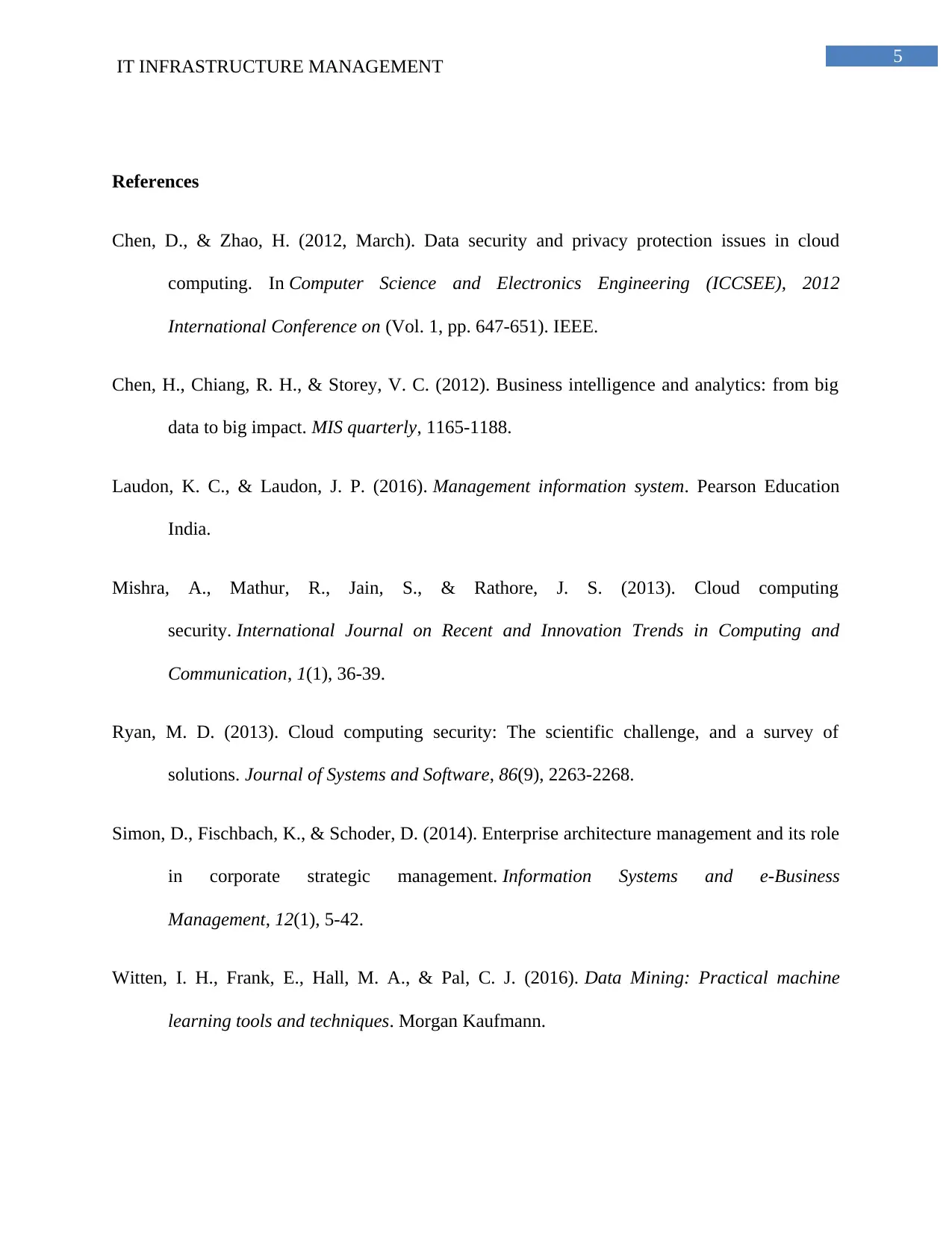
5
IT INFRASTRUCTURE MANAGEMENT
References
Chen, D., & Zhao, H. (2012, March). Data security and privacy protection issues in cloud
computing. In Computer Science and Electronics Engineering (ICCSEE), 2012
International Conference on (Vol. 1, pp. 647-651). IEEE.
Chen, H., Chiang, R. H., & Storey, V. C. (2012). Business intelligence and analytics: from big
data to big impact. MIS quarterly, 1165-1188.
Laudon, K. C., & Laudon, J. P. (2016). Management information system. Pearson Education
India.
Mishra, A., Mathur, R., Jain, S., & Rathore, J. S. (2013). Cloud computing
security. International Journal on Recent and Innovation Trends in Computing and
Communication, 1(1), 36-39.
Ryan, M. D. (2013). Cloud computing security: The scientific challenge, and a survey of
solutions. Journal of Systems and Software, 86(9), 2263-2268.
Simon, D., Fischbach, K., & Schoder, D. (2014). Enterprise architecture management and its role
in corporate strategic management. Information Systems and e-Business
Management, 12(1), 5-42.
Witten, I. H., Frank, E., Hall, M. A., & Pal, C. J. (2016). Data Mining: Practical machine
learning tools and techniques. Morgan Kaufmann.
IT INFRASTRUCTURE MANAGEMENT
References
Chen, D., & Zhao, H. (2012, March). Data security and privacy protection issues in cloud
computing. In Computer Science and Electronics Engineering (ICCSEE), 2012
International Conference on (Vol. 1, pp. 647-651). IEEE.
Chen, H., Chiang, R. H., & Storey, V. C. (2012). Business intelligence and analytics: from big
data to big impact. MIS quarterly, 1165-1188.
Laudon, K. C., & Laudon, J. P. (2016). Management information system. Pearson Education
India.
Mishra, A., Mathur, R., Jain, S., & Rathore, J. S. (2013). Cloud computing
security. International Journal on Recent and Innovation Trends in Computing and
Communication, 1(1), 36-39.
Ryan, M. D. (2013). Cloud computing security: The scientific challenge, and a survey of
solutions. Journal of Systems and Software, 86(9), 2263-2268.
Simon, D., Fischbach, K., & Schoder, D. (2014). Enterprise architecture management and its role
in corporate strategic management. Information Systems and e-Business
Management, 12(1), 5-42.
Witten, I. H., Frank, E., Hall, M. A., & Pal, C. J. (2016). Data Mining: Practical machine
learning tools and techniques. Morgan Kaufmann.
⊘ This is a preview!⊘
Do you want full access?
Subscribe today to unlock all pages.

Trusted by 1+ million students worldwide
1 out of 6
Related Documents
Your All-in-One AI-Powered Toolkit for Academic Success.
+13062052269
info@desklib.com
Available 24*7 on WhatsApp / Email
![[object Object]](/_next/static/media/star-bottom.7253800d.svg)
Unlock your academic potential
Copyright © 2020–2025 A2Z Services. All Rights Reserved. Developed and managed by ZUCOL.



